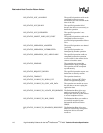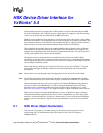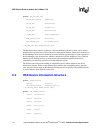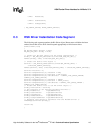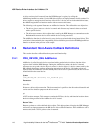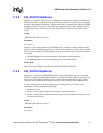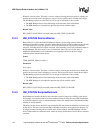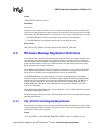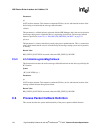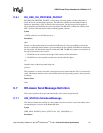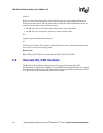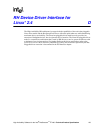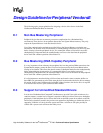
118 High Availability Software for the Intel
®
NetStructure
TM
ZT 4901 Technical Product Specification
HSK Device Driver Interface for VxWorks* 5.4
Pointer to a device object. This data is a device context allowing the device driver to identify the
specific device whose state is changing to stopped. Device-specific data is located in this object.
The HA Manager places no restrictions on size or type of data used for two reasons:
• The HSK Manager has no direct knowledge of the structure of this information
• The HSK Manager is not required to perform any actions with this object
Return Value
HSI_STATUS_SUCCESS if successful; otherwise HSI_STATUS_FAILURE
C.4.4 HSI_STATUS RemoveDevice
RemoveDevice is called when the HA Manager detects a device being removed from the
backplane in an orderly fashion. “Orderly” means that the device and driver adhere to the PICMG
2.1 CompactPCI Hot-Swap Specification. The driver should release all previously allocated
resources, including the device object extension. After returning a successful completion status to
the HA Manager, the device state is set to Uninitialized. Once a device is in this state, an
AddDevice and StartDevice call combination are required for the device driver to begin
communications with the actual device.
Syntax
( PRH_DEVICE_OBJ deviceobject )
Parameters
deviceobject
Pointer to a device object. This data is a device context, allowing the device driver to identify the
specific device whose state is changing to removed. Device-specific data is located in this object.
The HA Manager places no restrictions on size or type of data used for two reasons:
• The HSK Manager has no direct knowledge of the structure of this information
• The HSK Manager is not required to perform any actions with this object
Return Value
HSI_STATUS_SUCCESS if successful; otherwise HSI_STATUS_FAILURE
C.4.5 HSI_STATUS SurpriseRemoval
SurpriseRemoval notifies the device driver that the system no longer has visibility to the device;
for example, if an operator removes a board without waiting for blue hot-swap LED illumination,
or if a hostile takeover occurs in which backplane control was transitioned to the Redundant Host
without an orderly handoff.
The driver for this device should fail any outstanding I/O and release the hardware resources used
by the device. The driver must ensure that no attempts are made to access the device because it is
no longer present. Following the successful return of this callback, the HSK Manager calls the
driver’s RemoveDevice callback routine, where an orderly deallocation of device driver resources
can occur.



